RISE OF NEW RELIGION
- The post Vedic society was divided into 4 varnas viz. Brahmins, Kshatriya, Vaishyas and Shudras.
- Birth had become the basis of varnas and two higher varnas viz. Brahmins and Kshatriya were given privileges.
- The later period saw tensions rising in the varnas:
- The two dominant varnas Brahmins and Kshatriya competed for dominance.
- Kshatriya acted as rulers and the reacted against the domination of the priests of Brahmins.
- There is a story in Jain Mythology that Vardhamana Mahavira was to be born as a son of a Brahmin lady Devananda, but as all the Tirthankaras were Kshatriya by birth, Indra transferred the baby in the womb of a Kshtriya Trishla.
- This story might be the part of a campaign at that time which tended to prove the superiority of Kshatriya over Brahmins.
- Both Gautam Buddha and Mahavira Jain basically disputed the authority of the Brahmins.
- Apart from that India was now developing as a agro based economy.
- The importance of trade increased and Vaishyas started getting more importance.
- The Vaishyas came at third position after the Brahmins and Kshatriya and they looked for other religious which could improve their position.
- The money lending was a trade in post Vedic era, but Brahmins looked down upon this business.
- The Vaishyas wanted some better religious position and that is one of the regions that the trader community “Vaishyas” provided support to both Jainism and Buddhism.
- There was practice prevalent in the Vedic era that was killing the cattle for sacrifices.
- This ritual was not accepted in the new agro economy.
- In fact except Brahmins, almost all common public was irked by the ritualistic practices of the post Vedic period based upon exaggeration, superstition, Brahminical dominance.
- The position of Shrudas got worse to worst.
- Sanskrit which was the prime language in the Vedic and post Vedic period now started losing charm.
- Most people spoke Prakrit.
- The position of women for inferior.
- Buddhism and Jainism were the movements that started to reform the Hinduism.
Buddhism
What is a Buddha?
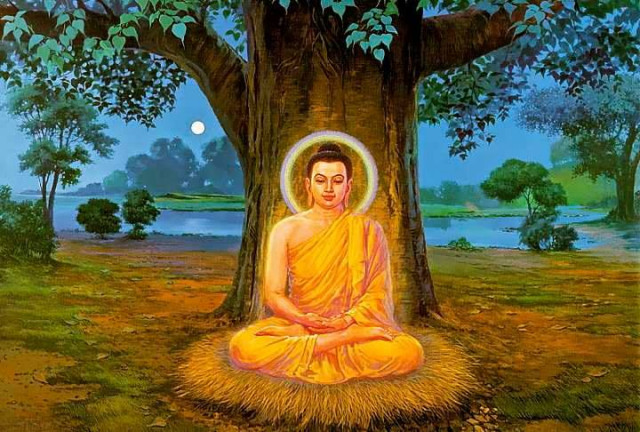
- Buddhahood in Sanskrit is Buddhatva.
- In Pali is it called Buddhatta or buddhabhava.
- It is the state of perfect enlightment attained by a Buddha.
- The perfect enlightment is sammasasmbodhi in Pali.
- This refers to the universal and innate property of absolute wisdom.
Is there only one Buddha i.e. Gautam Buddha?
- The Buddhavamsa is a text which is part of the Pali canon of Buddhism.
- It deals with the life of Buddha.
- It mentions 29 Buddhas in all.
- The 27 Buddhas, preceded Gautam Buddha and Maitreya, the 29th Buddha is next to come in future.
- Gautam Buddha was 28th
- The Buddhavamsa related that in the present Kalpa, there are 5 Buddhas.
- Kakusandha
- Konagamma
- Kassapa
- Gautama
- Maitreya
- The fifth Maitreya is a future Buddha.
- The first among these 5 Buddhas of the present Kalpa is Kakusandha.
- Kakusandha is mentioned in the Sanskrit Buddhist texts as Krakucchanda.
- In Tibet he is known as Khorvadjig.
- He was born in Nepal, near Kapilvastu.
- He attained enlightment under a sirisa tree.
- The second Buddha of the present Kalpa was Konagamma
- Their Buddha was Kassapa.
- In Sanskrit Buddhist texts, he is known as Kasyapa.
- He was also born in Nepal and attained enlightment under a Banyan tree.
Buddhas of the Ananda temple
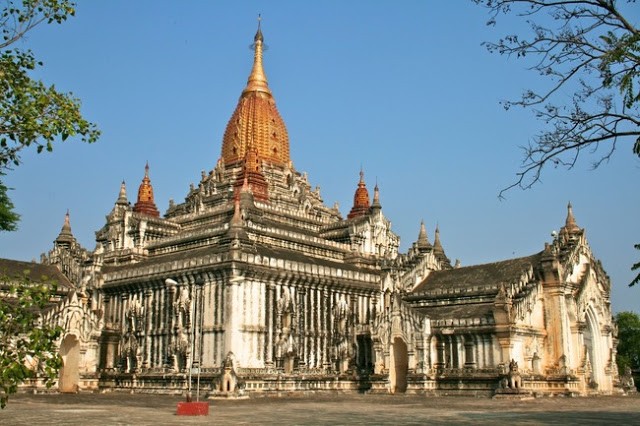
- Ananda temple is located in Bagan, in Burma.
- This temple was built in 1105 AD during the reign of King Kyanzittha.
- It has four standing Buddhas which are adorned with gold leaf and each Buddha image faces a direction.
- Kakusandha is North facing, Kassapa is south facing, Kongamana is east facing and Gautama is west facing
Life of Gautam Buddha
- Gautam Buddha is the historial Buddha of Buddhism.
- He founded Buddhism and is known as Supreme Buddha or sammasambudha or samyaksambuddha.
- He was born in Lumbini, a little personality of Kapilvastu in modern day Nepal.
- His childhood name was Siddhartha.
- He was son of Shuddodhana a leader of the Shakya clan,
- The capital of the Sakya clan was Kapilvastu and it was not a monarchy but a sort of Republic.
- Queen Mahamaya was the name of Gautam Buddha.
- Hathras district of Uttar Pradesh was renamed as “Mahamaya Nagar”, after Buddha’s mother.
- The birth of Buddha is celebrated a Vesaka in some countries.
- In India is Buddha Purnima.
- Queen Mahamaya died soon after his birth and he was raised by Maha Prajapati or Prajapati Gautami.
- He was a prince so he had lived his early childhood in luxury.
- His father wished him to be a great king and he was shielded from the religious teachings or human sufferings.
- But, as a child Gautama used to be absorbed in philosophical musings.
- He got married at the age of 16 with Yashodhara,
- She gave birth to a son, Rahula.
- At the age of 29, while going to meet his subjects he encountered human sufferings such as old age, death and diseases.
- He used to ask his charioteer Channa about these sufferings.
- He deeply depresses by the truth that human life is momentary and one has to suffer a lot.
- He left his home at the age of 19 years, so that he could overcome old age, illness and death by living a life of an ascetic.
- This is called “the great departure or Mahabhinishkramana”.
- He first went to Rajgriha Rajgaha or Rajgir.
- He started begging alms over there and living life of an ascetic.
- The King Bimbisara after a request from Kind Shuddodhana launched a search and Siddhartha was recognized by the men of Bimbisara.
- Bimbisara offered him a throne, but Gautama refused.
- He left Rajgir but promised Bimbisara to visit his capital Magadha, later.
- He studied under two hermits Alara and Udaka.
- He achieved high knowledge and was asked to succeed Udaka, but he was not satisfied with the path and his goal so he refused.
- The experiments with the life if asceticism could not bring desired fruits for Gautama.
- He left the Udaka, and moved on with 5 companions who were led by Kaundinya.
- They set out for more austerity.
- They tried enlightenment through total deprivation of worldly goods including food.
- This led him to starving near death condition, and one day he collapsed into a river and almost drowned.
Name of the horse was Kanthaka

- This led him to reconsider the path.
- He started moving away from asceticism and moving closer to mediating and this is called the middle path, the path of having oneself away from extreme self indulgence and extreme self mortification.
- He accepted milk and rice pudding from a village girl called Sujata.
- While meditating under a Pipal tree on the bank if river Niranjana at Gaya, he came across the desired truth, at the age of 35 years and after 49 days of meditating.
- He was now called Buddha or “Shakyamuni Buddha” which means the Buddha of Shakya Clan.
- Gautama Buddha never indulged himself in the abstract issues such as existence of God, Brahma and Soul etc.
- The basic purpose of Gautama Buddha’s teaching was to seek remedy from the sorrow of the human life and seek happiness.
- His teachings categorized in 4 Eternal Truths provide the practical solution to the worldly problems and don’t indulge in abstract debate.
- The first disciples of Buddha after becoming enlightened were two merchants named Tapussa and Bhallika.
- After becoming enlightened, he sought to find his former teachers Arada and Udaka to teach them, but they had died..
- He then looked for Kaundinya and other companions.
- Gautama Buddha now preached his first sermon which deals with the four noble truths and the noble eightfold path, the core pillars of Buddhist teaching regarding the intrinsic suffering of existence and how to deal with it.This was called Dhammacakkappavarrana Sutta.
- Kaundinya and 4 others became the first human beings to be taught Buddhas’s reaching and become an arhat (spiritual practitioner).
- This event took place at Deer park near Varanasi.
- Two gems of Buddhism viz. Buddha and Dhamma were now ready.
- The 5 disciples and Buddha formed the first union of Buddhism which is called Sangha.
- So, with the formation of a Sangha, the three gems of Buddhism (Buddha, Dhamma ans Sangha) were completed.
- The remaining years of life, Buddha travelled many parts of the country and established the Sangha also spread in many parts.
- As promised previously Buddha now travelled to Magadha, the capital of King Bimbisara.
- During this visit Sariputta (who later founded Theravada tradition) and Mahamoggallana became Buddhas’s discipline
- Sariputta, Mahamoggallana, Mahakasyapa, Ananda and Anuruddha comprised the five chief disciples.
- His ten foremost disciples were completed by the quintet of Upali, Subhoti, Rahula, Mahakaccana and Punna.
- Rahula was his son, who became disciple at the age of 7.
- Buddha’s parinirvana happened at Kusinagara at the age of 80 years.
Symbols of 5 great events of Buddha’s life:
| Buddha’s birth | Lotus and Bull |
| The great departure (Mahabhinishkramana) | Horse |
| Enlightment (Nirvana) | Bodhi Tree |
| First sermon (Dhammachakraparivartan) | Wheel |
| Death (Parinirvana) | Stupa |
Buddha’s teachings
Four Noble Truths:
Four noble truths were taught by Buddha in Dhammachakraparivartan. They are the core teachings of Buddhism.
Dukkha or “sorrow”:
The world is full of sorrie and everything from birth to death brings sorrows in life.
Dukkha Samudaya or cause of sorrow:
The cause of sorrow is desire. It is the un- fulfillment of human desire which leads him to the vicious cycle of births and rebirths.
Dukkha Nirodha or Prevention of sorrow:
It is possible to prevent sorrow. Man can get rid of sorrow by triumphing over the desires.
Dukkha Nirodha Gamini Patipada Magga or the path of Prevention of sorrow:
Man can avoid Dukkha by avoiding extremes of life and following middle path or Madhyam Patipada. The life of moderation and self control along with pursuance of 8 fold path is essential to prevent the Dukkha.
Eight fold path or Astangika marg
The eight fold path was recommended to eliminate the human misery. It basically comprises of 3 basic divisons of wisdom.
(Pragya Skanda), Ethical conduct (Sheel Skanda) and concentration (Samadhi Sakanda)
Concept of Nirvans:

- The concept of Nirvana in Buddhism is entirely different from the Hindusim.
- Buddhism denied the concept of Moksha, however it defines Nirvana has to getting rid of cycle of death and birth.
- It is achieved in the lifetime itself and not after death.
- To achieve nirvana one should follow moral code of conduct.
Buddhist literature
Tripitaka

Tripitaka or three baskets is a traditional term used for various Buddhist scriptures. It is known as pali canon in English. The three pitakas are Sutta Pitaka, Vinaya Pitaka and Abhidhamma Pitaka.
Sutta Pitaka
- Theravada school Tripitaka is the only complete Tripitaka preserved in Pali.
- Sarvastivada is a near complete Tripitaka written in Sanskrit and preserved in Sanskrit, Chinese and Tibetan.
- The 7 books of Abhidhamma Pitaka survive in Chinese translation.
- Dhammaguptaka tripitaka is written in Gandhari.
- Other version of Tripitaka are Mahisasaka, Mulasarvastivada and Kasyap Tya.
- It contains over 10 thousand suttas or sutras related to Buddha and his close companions.
- This also deals with the first Buddhist council which was held shortly after Buddhas’s death, dated by the majority of recent scholars around 400 BC, under the patronage of king Ajastasatru with the monk Mahakasyapa presiding, at Rajgir.
- Its sections are:
- Digha Nikaya: Comprises the “long” discourses in 34 long sutras.
- Majjhima Nikaya: Comprises the “middle- length” discourses in 152 sutras.
- Samyutta Nikaya: Comprises the “connected” discourses in over 2800 sutras.
- Anguttara Nikaya: Comprises the “numerical” discourses in over 9600 sutras.
- Khuddaka Nikaya: Comprises the “minor collection”. It has 15-17 booklets. (Thai 15. Sinhali 17 and Burmese 18 booklets).
Vinaya Pitaka:
The subject matter of Vinaya Pitaka is the monastic rules for konks and nuns. It can also be called as Book of Discipline.
Suttavibhanga:
The basic code of Monastic discipline is known as Patimokkha. It contains 227 rules for fully ordained monks called bikkhus (Maha vibhanga) and 311 rules for fully ordained nuns called Bikkhunis (Bikkhuni Vibhanga). They are contained in Suttavibhanga, one of the parts Vinay Pitaka.
Khandhaka:
Khandhaka is the second book of Vinay Pitaka. It has two volumes viz. Mahavagga and Cullavagga. Mahavagga deals with the awakening of Buddha and his great disciples. Cullavagga deals with the first and second Buddhist councils and establishments of community of Buddhist nun and rules for Buddhist community.
Parivara:
Parivara is the last book of Vinay Pitaka. It covers the summary of analysis of rules mentioned in first two books of Vinay Pitaka. It is the latest book and seems to be later than the fourth Buddhist council in Ceylon. It also contains questions and answers.
Abhidhammapitaka:
Abhidhammapitaka deals with the philosophy and doctrine of Buddhism appearing in the suttas. However, it doean not contain the systematic philosophical treatises. There are 7 works of Abhidhamma pitaka which most scholars agre that don’t represent the words of Buddha himself. The books are
Dhammasangani:
It contains a matrix which lists the classification of Dhammas or ideas.
Vibhanga:
It has 18 chapters dealing with different teachings of Buddhism. It is in 3 volumes and third volume is in question answer format.
Dhatukatha:
It has a matrix and various topics.
Puggalapannnatti:
It has a matrix which deals with the list of the persons.
Kathavatthu:
It contains the debates and commentary on these debates.
Yamaka:
Yamaka has questions in pairs and understanding.
Pattana:
It also contains the questions and answers.
Collection of Buddha’s sermons and teachings- Sutta Pitaka
- Digha Nikaya
- Majjhima Nikaya
- Samyutta Nikaya
- Anguttara Nikaya
- Khuddaka Nikaya
Deals with the governing rules of angha and monks- Vinaya Pitaka
- Suttavibhanga
- Maha vibhanga
- Bikkhuni vibhanga
- Khandhaka Mahavagga
- Cullavagga
- Parivara
Deals with Buddhist philosophy Abhidhammapitaka
- Dhammasangani
- Vibhanga
- Dhatukatha
- Puggalapannatti
- Kathavatthu
- Yam aka
- Patthana
Prominent literacy works
Jatakas:
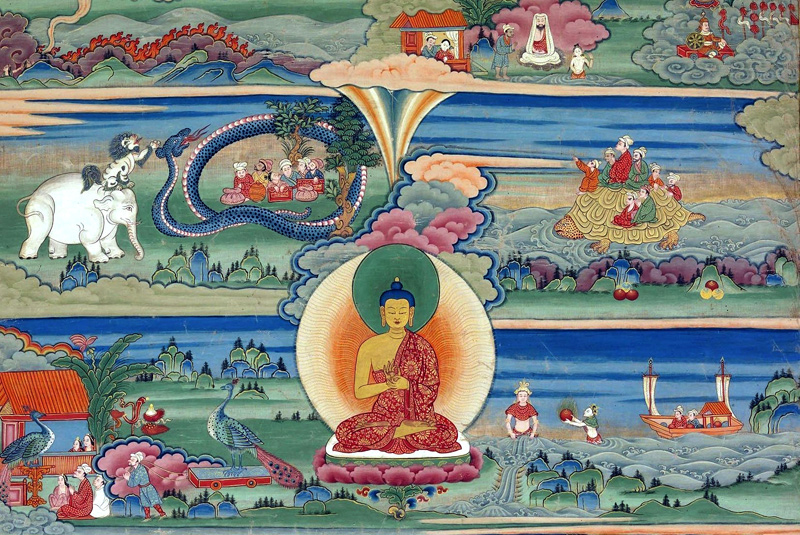
- Jatakas are very much close to folklore literature and they contain the tales of previous birth of Buddha in poems.
- The Jataka have also been mentioned in the Khuddaka Nikaya.
- There are 547 poems.
- In Sankrit it is called Jatakamala,In Khmer they are known as Cietak and in Chinese they are called Sadok.
Milinda Panha:
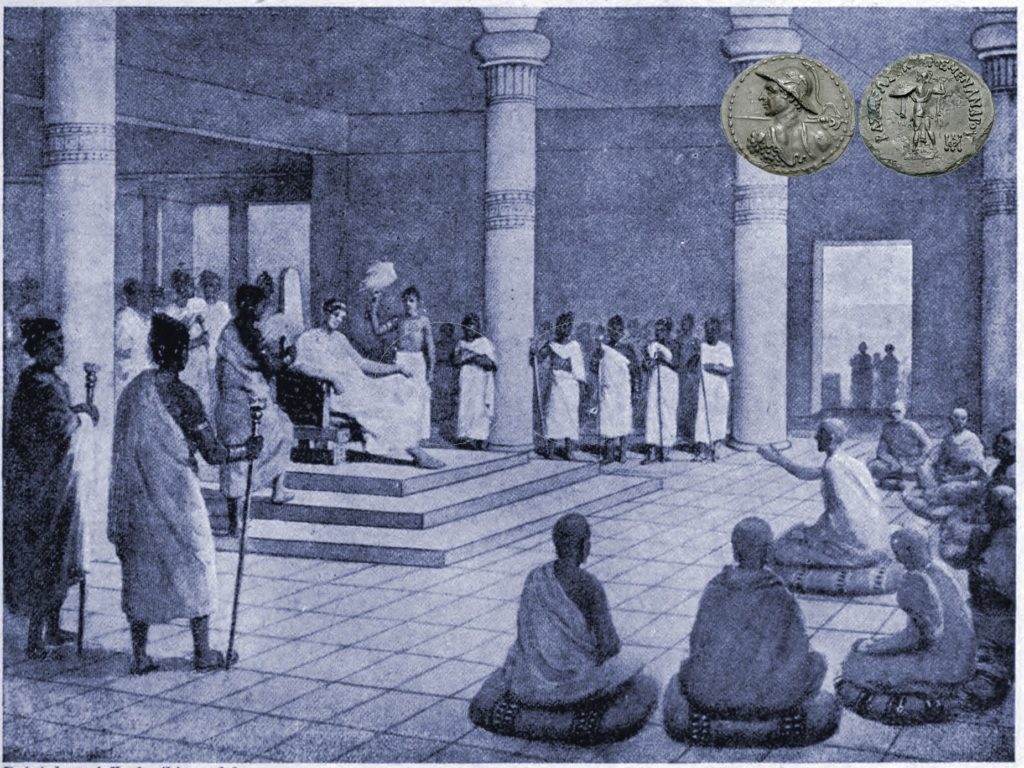
- Milinda Panha means “Questions of Milinda”.
- It contains the dialogue if Indo- Greek King Meander and Buddhist monk Nagasena.
- It has been written in second to first century BC and initially written in anskrit.
- There is only one copy in Sri Lankan Pali of this work.
- It was printed in the 6th Buddhist council in 1954.
Dipavamsa:
- The meaning of Dipavamsa is “Chronicle of Island”.
- It is the oldest historical record of Sri Lanka.
- It is believed to have been compiled around 3rd or 4th BC somewhere in Anuradhapura in Sri Lanka during the reign of King Dhatusena of Sri Lanka, the first Mauryan king of Sri Lanka.
The Anukana Buddha statue was erected by King Dhatsena in Sri Lanka:
- Dipavamsa is one of the most important works in Pali literature.
- It details the tooth relic and Bodhi tree’s arrival in Sri Lanka.
- It also deals with the arrival of Buddha’s teaching and preachers in Sri Lanka.
- It mentions that Buddha visited Kelaniya and Dighavapi in Sri Lanka.
Mahavamsa:
- Mahavamsa is the most important Pali epic poem Mahavamsa means “Great Chronicle”.
- It’s a historical poem in Pali language which deals about the king of Sri Lanka.
- The first version of Mahavamsa dates back to 3-4 th century BC during the reign if King Vijaya.
- The Mahavamsa, Dipavamsa, Culavamsa (small chronicle) all together are sometimes known as Mahavamsa.
- It deals with the royal dynasties of not only Sri Lanka but the whole Indian subcontinent and is known as world’s longest unbroken historical accounts.
- The consecration of Asoka and details of Selucus and Alexander have been detailed in it.
Mahavastu:
- Mahavastu means the “Great event”.
- Its a work in prose and verse and is written in Sanskrit, Pali and Prakrit.
- It details the miracles and earlier lives of Buddha.
Buddha charita:
- Buddha charita is an epic style Sanskrit work by Ashavaghosa and was compiled in second century BC.
- Dharmaraksa who is known to have translated many works of Buddhism in Chinese; translated this work in Chinese in 420 AD.
- It mainly deals with Buddha’s life.
- Asvaghosa also wrote a Sanskrit Drama “Sariputra Parakaran” which deals about Sariputta or Sariputra the disciple of Buddha.
Mahavibhaa sastra:
- It is an early Sankrit work on Buddhism.
- Vibhasa means a compendium and has 3 prongs.
- It is attributed to vasumitra and deals with not only Buddhism but also Vaisheshika and Samkya philosophies.
Lalitavistara:
- In Sanskrit Lalit is a Lotus.
- Lalitvistara is a Sanskrit text that deaks with the biography of Buddha.
Divyavadana:
- Divyavadana means divine tales.
- It contains anthology in 38 stories and is a Sanskrit text which deals with Mauryan and Sunga history.
- The Asokvadana is a story in it which deals with the legends of Asoka.
Udanavarga:
- Udanavarga is an early Buddhist Sanskrit text.
- It has verses attributed to Buddha and his disciples.
Udana:
- Udana is a Pali text included there in the Sutta Pitaka’s Khuddaka Nikaya.
- It contains the story of “Blind men and Elephants”.
Bodhi vamsa:
- Bodhi vamsa is a mix Sanskrit Pali text which was composed by Upatissa under the rule of Mahinda IV of Sri Lanka in 10th century AD.
- It describes the arrival of branch of Bodhi tree in Sri Lank and many other things which mentioned in Mahavamsa.
Prominent Buddhist scholars
- The most important turning point is the expansion of Buddhism in India was the emergence and conversion of Asoka the great (301- 232 BC).
- He embraced Buddhism after 8 years of his coronation, he became a Buddhist and made it his state religion in 260 BC.
- He convened the third Buddhist council, which was held in Pataliputra in the presidency of Moggaliputta Tissa.
- He launched a vigorous campaign to propagate Buddhism which could be called Asoka’s Dhamma.
- The main scholars of Buddha are as follows:
Asvaghosa:
- Asvaghosa is the greatest Indian poet Prior to Kalidasa, he is known as first Sanskrit Dramatist.
- His epics rivaled the contemporary Ramayana.
- He wrote Buddhist texts in classical Sanskrit.
- He was the court writer and religious advisor of Kushana King Kanishka.
- His main works are Buddhacharita, Mahalankara (book of glory) and Saundaranandakavya (details the life of Nanda).
Nagarjuna:
- Nagarjuna founded the Madhyamika school of Mahayan Buddhism.
- He was contemporary of Satavahana Kong Gautamiputra.
- He was born in a Brahmin family in Nagarjuna in modern Andhra Pradesh.
- Due to his birth in Brahmin family and later conversion in Buddhism, it can be justified that his early work was in Sanskrit and not in Pali or hybrid Sanskrit.
- Most important work is Mulamadhyamakakarika, which means fundamental verses on the middle way.
- His theory is also known as Shunyavad “emptiness”.
Asanga and Vasubandhu:
- Both were half brothers and proponents of Yogachara and Abhidhamma teachings.
- They were from modern Peshawar in Pakistan.
- Most important work of Vasubandhu was aAbhidharmamoksha.
Buddhaghosa:
- Buddhaghosa lived the 5th ventury AD and is known to be one of the greatest Pali scholar.
- His name means “voice of Buddha”, Considered to be most important commentator of the Thervada.
- Details of his life have been described in Mahavamsa and Buddhaghosuppatti.
- Please note Buddhaghosuppatti was not his work.
- He is said to have gone to Sri Lanka from India’s Magadha and settled in Anuradhapura.
- The most important work is Visuddhimagga.
Dignaga or Dinnaga:
- He is considered to be the founder of Buddhist logic.
Candraktrti or Chandrakirti:
- He was a disciple of Nagarjuna and a scholar at the Nalanda University.
- Prasannapada is his main work which means happy words or clear words.
Dharmakirti:
- Dharmakirti lived in 7th century AD and was primary theorist of Buddhist Sankya.
- He was a teacher at the Nalanda University and a poet.
- He has written seven treatises on valid cognitions.
- He has been called “Kant of India”.
Buddhist Sangeeti or councils
6 Buddhist councils have been convened. Here is a short description:
First Buddhist council: 400 BC
- Held soon after the Mahaparinirvana of the Buddha, around 400 BC under the patronage of King Ajatshatru with the monk Mahakasyapa presiding at Rajgriha, in the Sattapani cave.
- The idea was to preserve Buddha’s teachings (Sutta) and rules for discipkes (Vinaya).
- Ananda one of the greatest disciple of Buddha recited Suttas and Upanil, another disciple recited Vinaya.Abhidhamma Piataka was also includes.
- Conducted under the patronage of King Ajatasatru of Haryanka dynasty.
- The monk who presided over the first council was Mahakassapa.
Second Buddhist council: 383 BC
- It was held in 383 BC in Vaishali
- This idea of this council was to settle a dispute on Vinaya Pitaka, the code of discipline.
- The dispute was on 10 points such as storing salt in horn, eating after midday, eating once and going to villages for aims, eating sour milk after one’s meal etc.
- It was not settles and Buddhism sects appeared for the first time
- It was held at Vaishali.
- Sabakami presided over the council.
- Conducted under the patronage of King Kalasoka of Sisunaga dynasty.
The subgroups were Sthaviravada, Mahasanghika and Sarvastivada
- It was held at Vaishali under the patronage of King Kalasoka and the presidency Sabakami.
- Sthaviravada followed the teachings of the elders and Mahasanghika became extinct later.
- Sthaviravada later continued till 3rd Buddhist council.
Third Buddhist council: 250 BC
- Third Buddhist council was held in 250 BC at Pataliputra under the patronage of king Asoka and under the presidency of Moggaliputta Tissa.
- The teachings of Buddha which were under two baskets were now classified in 3 baskets as Abhidhamma Pitaka was established in this council, and they were known as “Tripitaka”.
- It also tried to settle all the disputes of Vinaya Pitaka.
- Conducted under the patronage of Emperor Ashoka of Maurya dynasty.
- The council was presided over by Mogaliputta Tissa.
Fourth Buddhist council: 72 AD
- The fourth Buddhist council was held at Kundalavana, Kashmir in 72 AD, under the patronage of Kushan King Kanishka and the president of this council was Vasumitra, with Asvaghosa as his deputy.
- This council distinctly divided the Buddhism into 2 sects Mahayan and Hinayan.
- Another fourth Buddhist council was held at Tambapanni (one name of Sri Lanka) at Aloka Lena under the patronage of Vattagamani- Abaya.
- However, most scholars agree that this was not eligible to be called a council as it was not under a king but a local chieftain.
- This council is also related to the cruel policy of Vattagamani- Abaya towards Jains, as it is said that a Jain premises was destroyed and a Mahayan temple was built.
- Conducted under the patronage of King Kanishka of Kushan dynasty.
Fifth Buddhist council: 1871
- Fifth Buddhist council took place in 1871 under the patronage of King Mindon in Mandalay, Burma.
- It was presided by Jagarabhivamsa, Narindabhidhaja and Sumangalasami.
- The idea was to recite all the teachings of the Buddha and examine them systematically if any of them was dropped or altered.
Sixth Buddhist council: 1954
- The sixth Buddhist council was held in 1954 in Burma at Kaba Aye in Yangoon under the patronage of Burmese government led by Prime Minister Li Nu.
- Construction of Maha Passana Guha, which is very much similar to India’s Sattapanni Cave where the first Buddhist council had been held was authorized by the government.
- It was aimed to preserve the genuine Dhamma and Vinaya Pitaka.
- It held under the presidency of Mahasi Sayadaw and Bhadanta Vicittasarabhivamsa, 500 Buddhist scholars from 8 countries participated in this council.
Hinayana and Mahayana
- A Yana is a vehicle.
- A Hinayana is a lesser vehicle while a Mahayana is a great vehicle.
Hinayana:

- Also called “Deficient vehicle”, the “Abandoned vehicle”, or the “Defective vehicle”.
- It believes in the original teaching of Buddha.
- Don’t believe in idol worship and try to attain individual salvation through self discipline and mediation.
- Stharvivada or Thervada is a Hinayana sect, which follows the “doctrine of elders”.
- Asoka patronized Hinayan and Pali the language of masses was use by the Hinayan scholars.
Mahayana:

- This sect believes in the heavenliness of Buddha and believes in idol worship.
- It is also called Bodhisattva vehicle.
- Mahayana Buddhism spread from India to China, Japan, Vietnam, Korea, Singapore, Taiwan, Nepal, Tibet, Bhutan and Mongolia.
- Zen, Pure land, Tiantai and Nichiren, Shingon and Tibetan Buddhism are traditions of Mahayana.
- Fundamental principles of Mahayana doctrine were based on the possibility of universal liberation from suffering for all beings (hence the “Great Vehicle”) and the existence of Buddhas and Bodhisattvas embodying Buddha nature.
- It allows salvation to be alternatively obtained through the grace of the Amitabha Buddha by having faith and devoting oneself to mindfulness of the Buddha.
- Believes in Mantras.
Major difference between Hinayana and Mahayana:
- Both adopt one and the same Vinaya, and they have in common the prohibitions of the five offenses, aand also the practice of the four noble truths.
- Those who venerate the bodhisattvas and read the Mahayana sutras are called the Mahayanists, while those who do not perform these are called the Hinayanists.
Bodhisattva
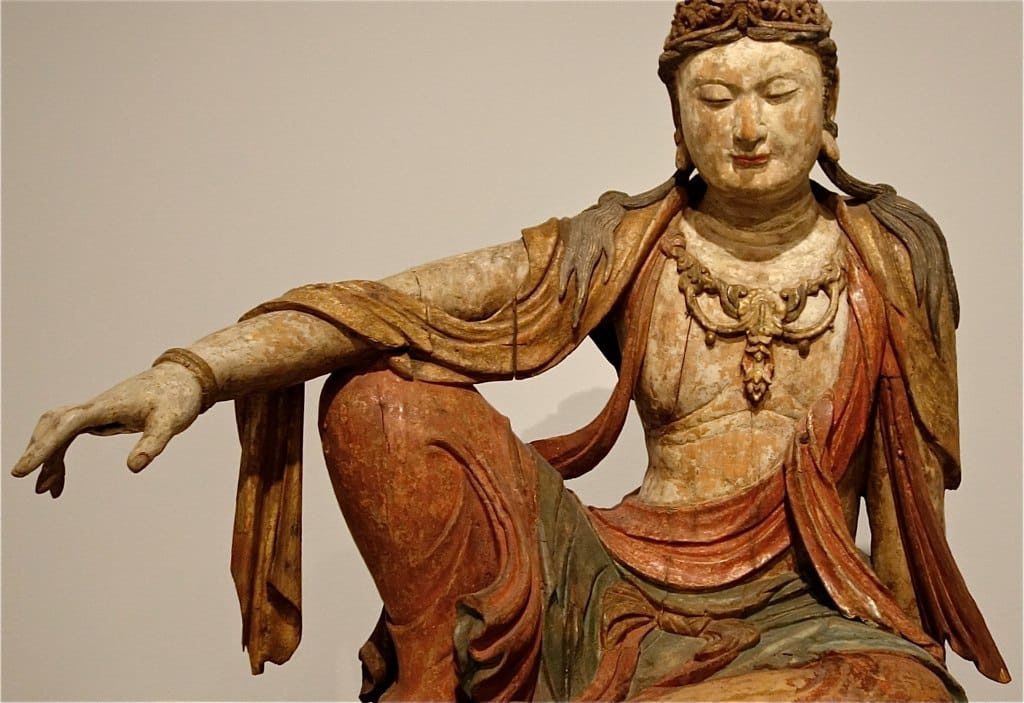
- A bodhisattva means one who has essence of enlightment.
- Anyone who has a spontaneous wish to attain Buddhahood for the benefit of all is a Bodhisattva.
- It’s a very popular subject in Buddhist art. A bodhisattva is bound to enlightment and refers to all who are destined to become Buddhas in this life or another life.
- There are celestial bodhisattvas which are manifestation of Gautam Buddha.
- Important 8 Bodhisattvas are as follows:
- Avalokistesvara

- Avalokitesvara encompasses all Buddhas.
- In China he is known as Guanshiyln Pusa, in Tibetan as Chenrezig, in Thai as Avalokitesvara.
- He is said to incarnate in Dalai Lama, he is depicted as holding a lotus flower.
- He is depicted as female also.
- A cave wall painting of Avalokitesvara is devoted in Ajanta caves as Padmapani.
- Manjusri:
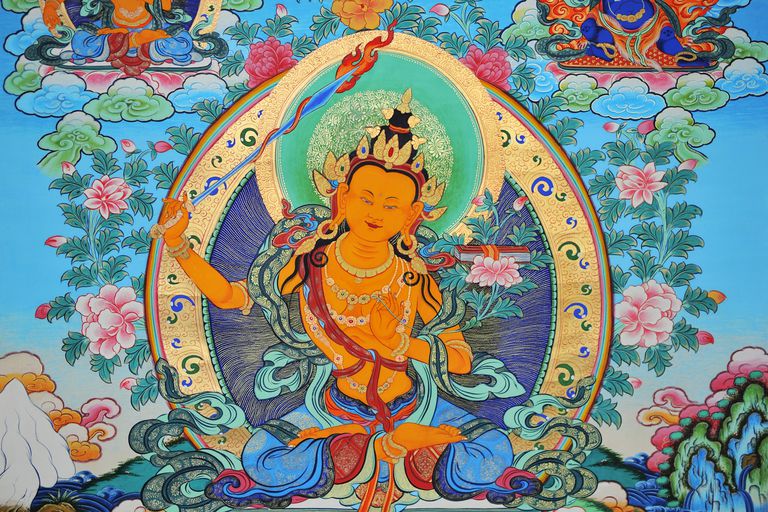
- He is known as Wenshu in Chinese, Jampelyang in Tibetan and is a manifestation of great wisdom and mediation.
- Manjusri is depicted as a male bodhisattva wielding a flaming sword in his right hand.
- Samantabhadra:
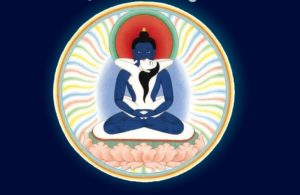
- Samantabhadra means Universal worthy and he is associated with meditation known as Fugen Bosatsu in Japanese and very popular among the Tendao and Shingon sects.
- His manifestation in action and he is key figure in flower Garland Sutra.
- Ksitigarbha:
- Ksitigarbha is usually depicted as a Buddhist monk in the Orient/ East Asia.
- Ksitigarbha means earth womb.
- He is regarded as Bodhisattva of earth or hell beings or Mortals.
- He is regarded as guardian of children and patron deity of deceased children and aborted fetuses and Ksitigarbha, Samantabhadra, Manjusri and Avalokitesvara are the principak Bodhisattvas of East Asian Mahayan Buddhism.
- Maitreya:
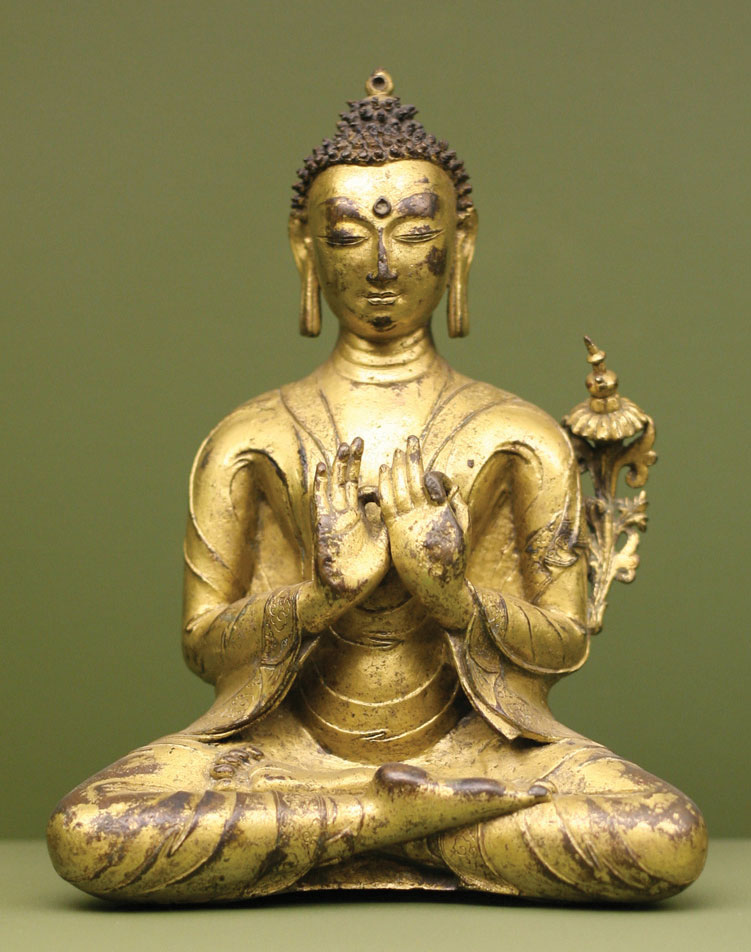
- Maitreya will be successor of Gautama Buddha.
- He is also known as Ajita Boddhisattva.
- He holds a “water phial” in his left hand.
- Earliest mention of Matteyya is in the Digha Nikaya 26 of the Pali canon.
- It is said that he will arrive when oceans will decrease in size (that is why keeps a Kumbha or phillai in his hand) and will rule the ketumati pure land (Varanasi), Budai or laughing Buddha is claimed to be an incarnation of Maitreya.
- Budai was a Chinese Zen monk who lived during the later Liang Dynasty (907-923 CE) in China.
- In Japanese, he is called Hotei and is one of the 7 Lucky Gods of Japan.
- Vajrapani:
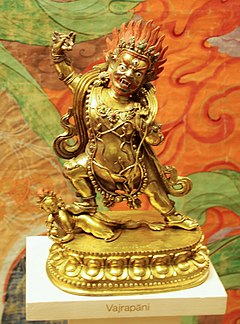
- Vajrapani is depicted as one of the 3 protective deities around Buddhism, other are Manjusri and Avlokiteshwara.
- Vajrapani manifests Buddha’s power
- Manjusri manifests Buddha’s wisdom and Avlokiteshwara manifests Buddha’s compassion.
- In Japan a dharma protector called Nio is called Vajrapani.
- Sadaparibhuta:
- Sadaparibhuta is a Bodhisattva which manifests “never disparaging” spirit.
- Akasagarbha:

- Akasagarbha is boundless as space.
- He is known as twin brother of Ksitigarbha.
- He is the manifestation of wisdom.
Buddhist Shrines
Astamah Asthanas:
Astamahasthanas are 8 great holy places. 4 are as follows:
- Lumbini: Birth of Buddha
- Bodhgaya: Enlightment of Buddha
- Sarnath: First sermon or Dhammachakraparivartan
- Kushinagar: Death or Mahaparinirvana
Along with them, Sravasti, Sankasya, Rajgir and Vaishali are known as Astamahasthanas.
Amaravati:
- Amaravati in Andhra Pradesh’s Guntur districy is also known as Dhaykataka or Dhanaranikota and was the site of a great Buddhist Stupa built in Pre- Mauryan times, ruled by Satavahana kings.
Nagarjunkonda:
- Nagarjunkonda is near Nagarjun Sagar in Andhra Pradesh.
- Once, it was home to more than 30 Buddhist Viharas (Buddhist universities and monasteried), attracting students from as far as China, Gandhara, Bengal and Sri Lanka.
- Nagarjunkonda was one the largest and most important Buddhist centres in South India from the second century BV and until the third who had migrated here from Amaravati to propagate and spread the Buddha’s message of universal peach and brotherhood.
- Remains were discovered in 1926 by archaeologist AR saraswati in 1926.
Ajanta caves:
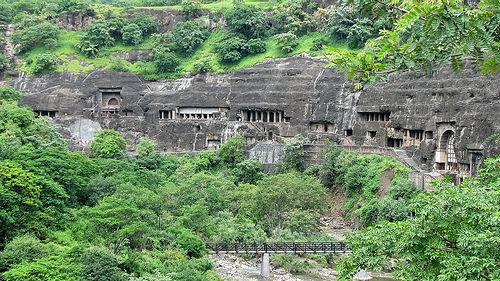
- Ajanta caves are 31 rock cut caves from 2nd to 8th century AD, located in Aurangabad.
- The first caves called Chaityas were created during Satavahana Dynasty.
- Cave no.1 has the painting of Padmapani and Vajrapani.
- Painted narratives of the Jataka tales are depicted on the walls.
Angkor wat:
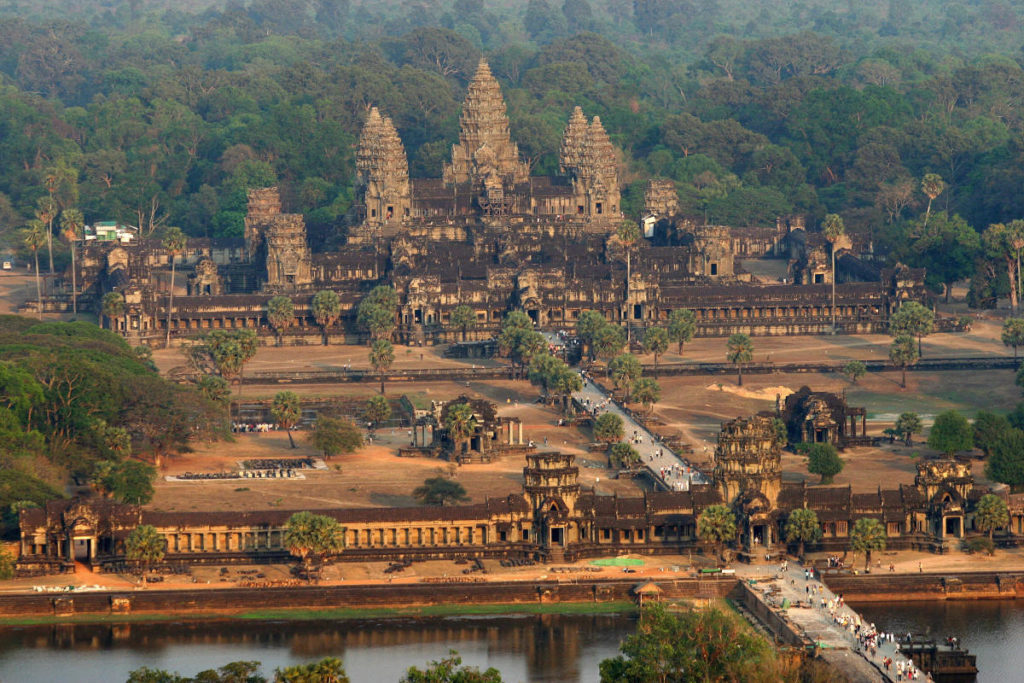
- Angkor wat is located in Cambodia.
- The temple complex was built by Suryavarmam II and it was first devoted to Vishnu and later to Buddhist.
Bodh Gaya:
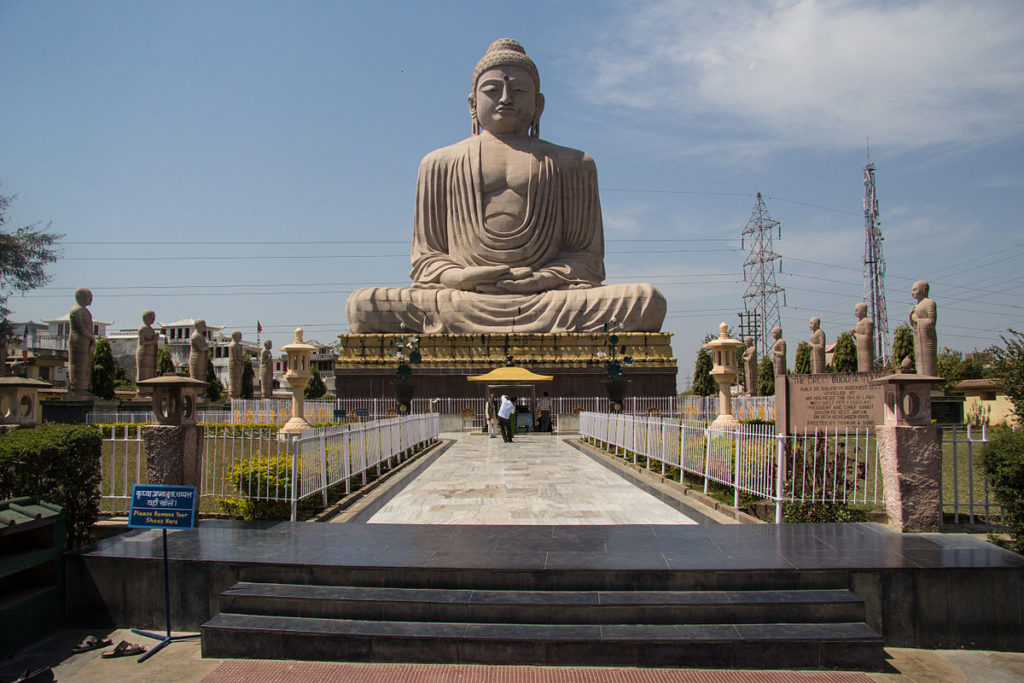
- Bodh Gaya was known as Bodhimanda, Urvel, Sambodhi, Vajrasana and Mahabodhi till 18th century when Bodh Gaya name became popular.
- It has the Mahabodhi temple and Bodhi tree.
- It became UNESCO world heritage site in 2002.
Bodhi tree:
- It’s a Pipal tree (Ficus Religiosa) and known as Bo in Sri Lanka, located in Bodh Gaya.
- Under this tree Gautama Buddha attained enlightment.
- The current tree is a descendent of the original tree.
- There are other Bodhi trees as well viz. Anandabodhi tree in Sravasti and the Bodhi tree (Bo) or also known as Jaya Sri Maha Bodhi planted in 288 BC in Anuradhapura, Sri Lanka and both of them have been propagated from the original tree.
- It is also known as oldest living human planted tree in the world with a known planting date.
Borobudur:
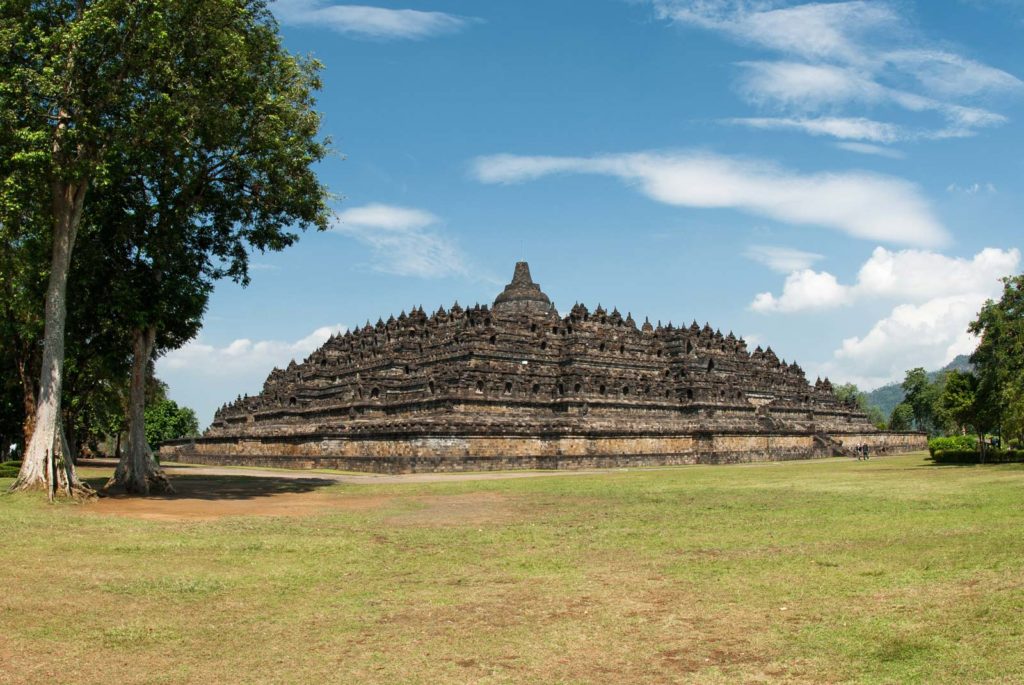
- Borodubar is located in Indonesia and comprises six square platforms topped by three circular platform, and is decorated with 2672 relief panels and 504 Buddha statues.
- It’s a world heritage site.
- There are 3 Buddhist temples which are known as Boroduvur temple compounds.
Bamyan Caves:
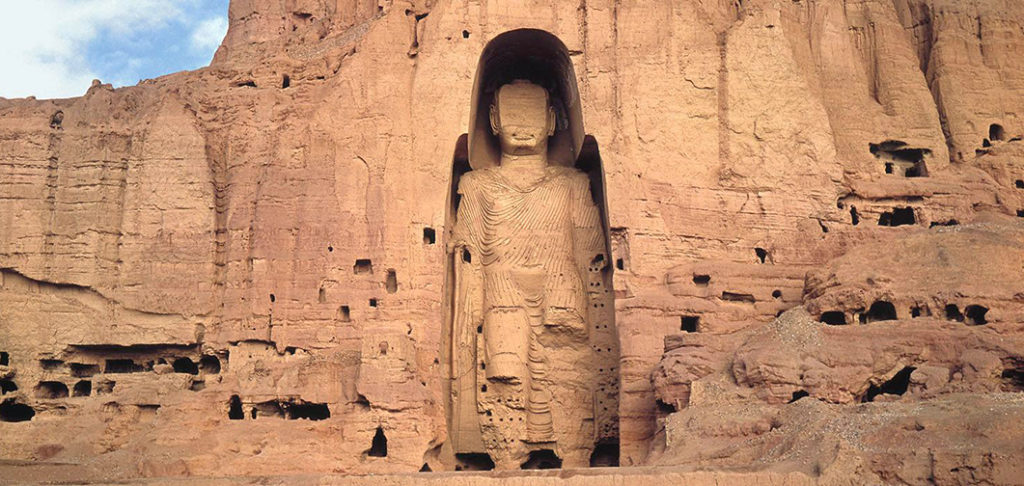
- They are located in Afghanistan and have statues represented the classic blended style of Gandhara art of 6th
- They were the largest examples of standing Buddha carvings in the world, before they were blown by dyanamite by Taliban in 2001.
Ellora Caves:
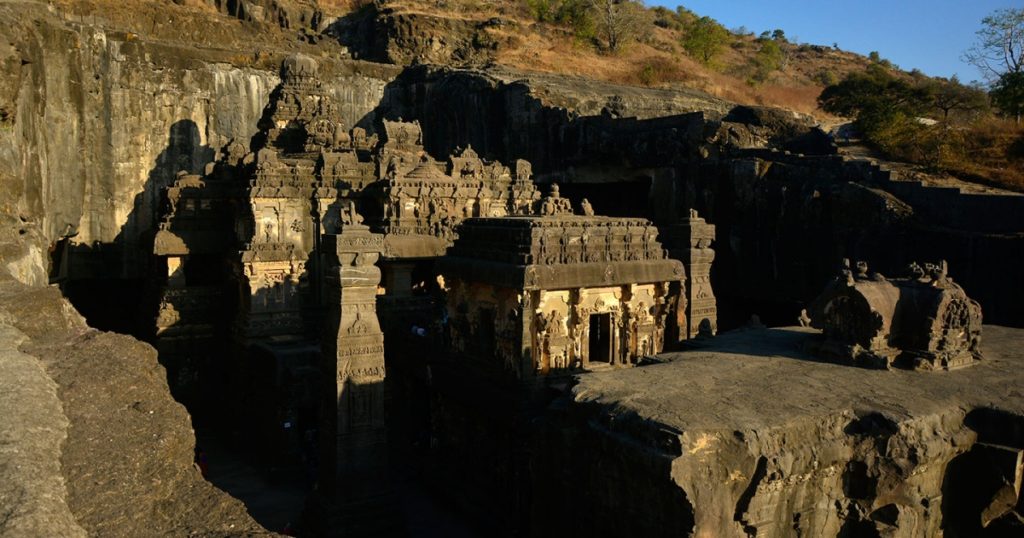
- Ellora Caves represent Buddhist, Jain and Hindu rock cut temples built by Rastrakuta kings.
- Earliest Buddhist cave is Cave 6; most caves of Buddhism are Viharas.
- Cave number 10 is a Chaitya hall also known as Chandrashala of Vishwkarma Cave and also known as carpenter’s cave.
- At heart of this cave is a 15 feet statue of Buddha seated in a preaching pose.
Pushpagiri University:
- Lalitgiri, Ratnagiri and Udayagiri are the part of the Pushpagiri University which flourished till 11th century in Orissa.
- They lie atop the Langudi hills in Jaipur and Cuttak of Orissa.
Important points:
- 2500th anniversary of Buddha’s mahaparinivana was celebrated in 1956.
- The birth and death details of Gautama Buddha was fixed on the basis of the Cantonese records of Chinese records.
- Sri Lanka is the country which propagated the Buddhism to South East Asian countries.
- Mahendra and Sanghamitra, son and daughter of Asoka visited Sri Lanka.
- Tooth relic was a canine teeth of Buddha which after many hands in Orissa and other parts was taken to Sri Lanka.
- Acharya Vasubandhu was a scholar who went to Nepal to propagate his own doctrine.
- Sron Btsan Sgam Po or Songtsan Gampo was the founder of the Tibetan empire and traditionally credited with being the first to bring Buddhism to the Tibetan people.
- In Japan Mahayan was introduced in 7th Zen Buddhism was introduced in 12th century mainly in Japan and key is mediation. Zen seems to have been derived from Dhayana in Sanskrit.
- In China, Buddhism was introduced in 1st century AD. Monks of Kuchi played very important role in Propagating Buddhism in China.
- Pala Kings Dharmapala and Devapala were great patrons of Nalanda University.
- Vikramshila, Odantapuri and Somapapuri were the Buddhist Viharas founded by Palas but not Nalanda.
- Asoka tried to bring Buddhism in strict discipline and similar effort was done by only Harsha.
- Kanishka’s reign was important because Mahayan rose during his time, Buddhism was introduced in China and Central Asia during his time.
- Buddha did not intended to establish a formal religion or doctrine that is why he did not talk about God, soul, life after death etc. he tried to provide the practical solution to human problems.
- Buddha practically believed in Doctrine of Karma.
- The middle path means a balanced life.
- Existence of sorrow is the basic truth.
- Another name of Buddha is Tathagat which means beyond all coming and going.
- Both Jain and Buddhism propounders were Kshatriyas and both somewhere drew their inspiration from Upanishads.
- Upostha is Upavasa or fast in Buddhism. The Buddhist monks keep 4 fasts in a month viz. New moon, full moon and 2 quarter moons.
